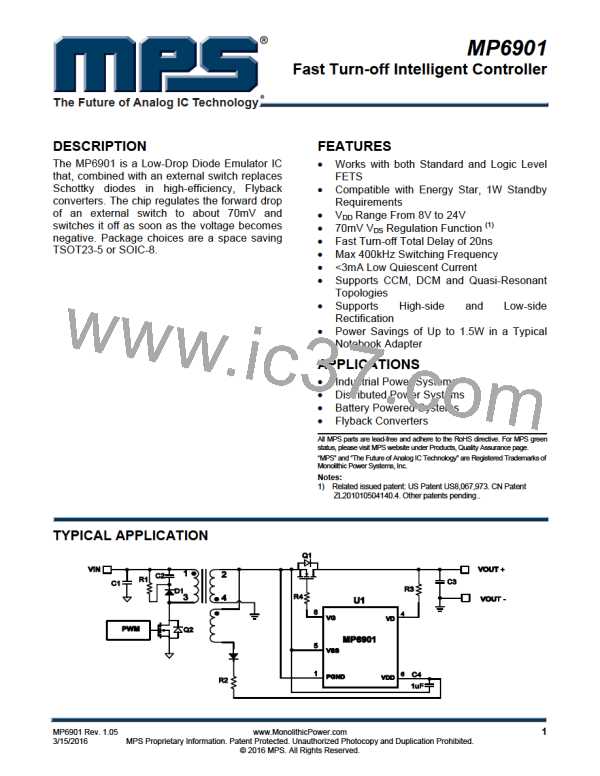MP6901- FAST TURN-OFF INTELLIGENT CONTROLLER
different Qg Mosfet by MP6902. From Fig.6, with
driving a 120nC Qg Mosfet, the driver ability of
Vds
-30mV
-70mV
MP6901 is able to pull up the gate driver voltage
of the Mosfet to ~5V in 300ns as soon as the
body diode of the Mosfet is conducting, which
greatly save the turn-on power loss in the
Mosfet’s body diode.
Id
50% SR Conduction Period
Ipeak
Isd
Ipeak˜ 4·IOUT
Ic
Ic˜ 2·IOUT
Vg
Vgs
t0
t1
t2
Figure 4—Synchronous Rectification
Operation at light load
SR Conduction Period
SR Mosfet Selection and Driver ability
Figure 5—Synchronous Rectification typical
The Power Mosfet selection proved to be a trade
off between Ron and Qg. In order to achieve high
efficiency, the Mosfet with smaller Ron is always
preferred, while the Qg is usually larger with
smaller Ron, which makes the turn-on/off speed
lower and lead to larger power loss. For MP6901,
because Vds is regulated at ~-70mV during the
driving period, the Mosfet with too small Ron is
not recommend, because the gate driver may be
pulled down to a fairly low level with too small
Ron when the Mosfet current is still fairly high,
which make the advantage of the low Ron
inconspicuous.
waveforms in QR Flyback
Turn-on Delay vs. Qg
350
300
250
200
150
100
50
0
0
20
40
60
Qg (nC)
80
100
120
140
Figure 6—Total Turn-on Delay vs. Qg
Fig.5 shows the typical waveform of QR flyback.
Assume 50% duty cycle and the output current is
IOUT
.
To achieve fairly high usage of the Mosfet’s Ron,
it is expected that the Mosfet be fully turned on at
least 50% of the SR conduction period:
Vds = −Ic ×Ron = −2⋅IOUT ×Ron ≤ −Vfwd
Where Vds is Drain-Source voltage of the Mosfet
and Vfwd is the forward voltage threshold of
MP6902, which is ~70mV.
So the Mosfet’s Ron is recommended to be no
lower than ~35/IOUT (mΩ). (For example, for 5A
application, the Ron of the Mosfet is
recommended to be no lower than 7mΩ)
Fig.6 shows the corresponding total delay during
turn-on period (tTotal, see Fig.2) with driving
MP6901 Rev. 1.05
3/15/2016
www.MonolithicPower.com
MPS Proprietary Information. Patent Protected. Unauthorized Photocopy and Duplication Prohibited.
© 2016 MPS. All Rights Reserved.
9

 MPS [ MONOLITHIC POWER SYSTEMS ]
MPS [ MONOLITHIC POWER SYSTEMS ]